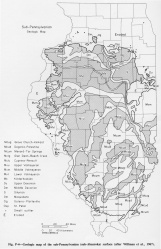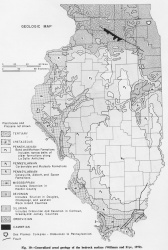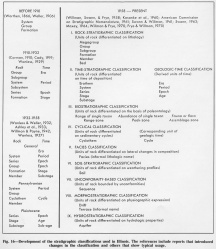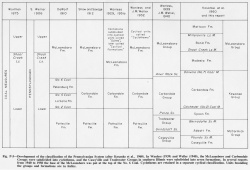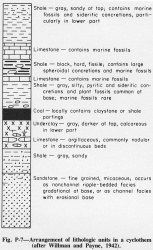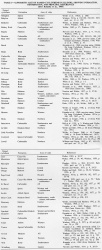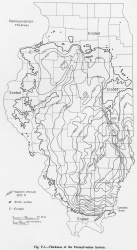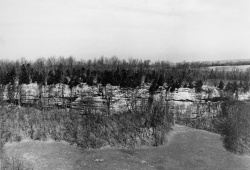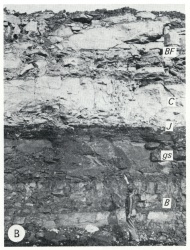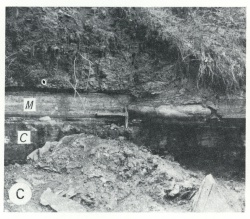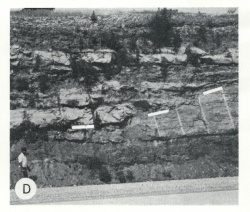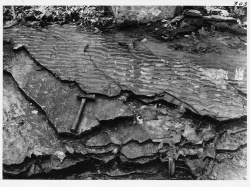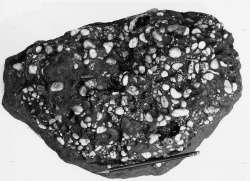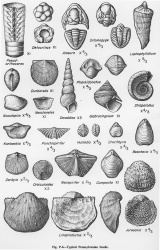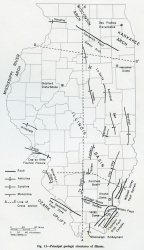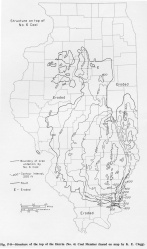Pennsylvanian Subsystem
Chronostratigraphy: Paleozoic Erathem >>Pennsylvanian Subsystem
Primary source
Willman, H. B., Elwood Atherton, T. C. Buschbach, Charles Collinson, John C. Frye, M. E. Hopkins, Jerry A. Lineback, and Jack A. Simon, 1975, Handbook of Illinois Stratigraphy: Illinois State Geological Survey Bulletin 95, 261 p.
Contributing author(s)
M. E. Hopkins and J. A. Simon
Name
Original description
Derivation
Other names
History/background
The name "Pennsylvanian Series" was introduced by H. S. Williams in a report on Washington County, Arkansas (Simonds, 1891, p. xiii), to designate strata generally called "Coal Measures". Later, the coal fields of Pennsylvania were named as the type area (Williams, 1891, p. 83). The name "Pennsylvanian" has been used in Illinois since the first report of the present Geological Survey (Weller, 1906a), but the terms "Coal Measures" and/or "Upper Carboniferous" were still used in many early reports of the Survey. The Pennsylvanian was classified as a series in Illinois until about 50 years ago and since then has been regarded as a system (fig . P-2).
Type section
Type location
Type author(s)
Type status
Reference section
Reference location
Reference author(s)
Reference status
Stratigraphic relationships
A major unconformity underlies the Pennsylvanian System (fig. P-4) and separates the Absaroka Sequence, which includes all the Pennsylvanian strata, from the Kaskaskia Sequence below. Pennsylvanian rocks overlie the youngest strata of the Mississippian System in extreme southern Illinois and progressively overlap older strata northward. In the extreme northern part of the coal basin, Pennsylvanian rocks directly overlie rocks of Ordovician and Silurian age.
The upper surface of the Pennsylvanian rocks is an eroded post-Pennsylvanian, pre-Pleistocene surface modified in part by further erosion during the Pleistocene (fig. 10). In a relatively small area in Adams, Pike, and Brown Counties in western Illinois, the Pennsylvanian is overlain by Gulfian (upper Cretaceous) rocks (Frye et al., 1964).
Because of the abrupt and distinct vertical variations in lithology and the widespread lateral continuity of many of the Pennsylvanian units, their classification has undergone many changes (fig. P-5). The present Pennsylvanian classification was adopted (Kosanke et al., 1960) to make it conform to the Illinois State Geological Survey policy on stratigraphic nomenclature (Willman et al., 1958) (fig. 16). The multiple classification adopted by the Survey permitted recognition of cycles as a separate and distinct classification, thus removing cyclothems from the rock-stratigraphic classification, where they had been used in place of formations. After several alternatives
for formations had been considered, the entire system was subdivided into seven formations, each a bundle of Pennsylvanian strata characterized by certain gross lithologic characteristics and separated from the overlying and underlying strata by the top or bottom of generally widely traceable members. The formations are differentiated by the relative abundance, character, and distribution of four basic lithologies-- sandstone, shale, coal, and limestone. Adjacent formations that have closely related lithologic characteristics are combined into a group and three groups are recognized.
The present time-stratigraphic classification of the Pennsylvanian System in Illinois (fig. P-2) is based on that developed in the Midcontinent Region and was first published by the Illinois State Geological Survey on the Geologic Map of Illinois (Willman et al., 1967). Correlations with Midcontinent strata are based on both biostratigraphy and rock stratigraphy, and many biozones and rock units of the Midcontinent Region can be identified in the Illinois Basin. The sediments were continuous before the two regions were separated by post-Pennsylvanian erosion. A time-stratigraphic classification of the Pennsylvanian System in Illinois based on ostracodes
(Cooper, 1946) used Midcontinent terms, but the correlations were not definitive and the classification was not followed.
Coal-bearing Pennsylvanian strata have been fairly precisely correlated from spores and pollen in the coals. Palynological studies of other lithologic units, however, have not been extensive. Major time-stratigraphic intervals are delineated by their most abundant spore taxa and by the occurrence of certain genera and species that have relatively short stratigraphic ranges. Some of these fossils are limited to two or three coals, whereas others extend through one or more series. A coal can generally be precisely correlated with a named coal member, or at least placed within an interval containing two or three named coal members.
The Pennsylvanian of Illinois includes strata belonging to the recognized series of the Midcontinent, from oldest to youngest: Morrowan, Atokan, Desmoinesian, Missourian,
and Virgilian (fig. P-2). Older strata of problematical age, sometimes referred to as the Springeran Series (Pennsylvanian and/or Mississippian), have not been recognized in Illinois. However, certain sink-hole or cave deposits lying on or in older carbonates in western and northeastern Illinois contain very early Pennsylvanian strata that have not been correlated with strata in other areas, although they are at present considered Morrowan. Because of the overlapping relations on the unconformity at the base of the Pennsylvanian, the basal Pennsylvanian strata vary in age, generally from Morrowan in southern Illinois to Atokan and Desmoinesian in western, northern, and eastern Illinois. The youngest Pennsylvanian strata in Illinois, found only at the top of the deepest part of the Fairfield Basin, belong in the lower part of the Virgilian Series. The spores of several coals preserved in down-faulted blocks in western Kentucky and adjacent southeastern Illinois suggest that most of the Virgilian may be represented in this part of the basin. Within the Pennsylvanian System in Illinois, no major, widespread unconformities with either large-scale overlaps or structural discordances are evident. Numerous erosional episodes, however, occurred during the development of fluvial and deltaic sandstones.
The many individual units of the Pennsylvanian generally occur in an orderly sequence, and the sequences are repeated many times throughout most of the succession. Although
the idealized sequence shown in figure P-7 is rarely complete, the units that are present have the same relative position in the sequence. These sequences were early
recognized as cycles of sedimentation (Udden, 1912; Weller, 1930, 1931) and were subsequently termed "cyclothems" (Wanless and Weller, 1932).
Cyclothems have been used extensively in geologic reports in the past 40 years (Wanless, 1929 [called suites], 1931a [called cyclical formations], 1957; Willman and Payne, 1942), but they are not entirely adequate for rock-stratigraphic classification. They are much smaller units than the formations and are most useful in detailed differentiation and field mapping of the Pennsylvanian sediments. The named cyclothems are listed in table 3.
Extent and thickness
Strata of the Pennsylvanian System constitute the bedrock in about two-thirds of the area of Illinois (36,806 out of 56,400 square miles) and underlie all or parts of 86 of the 102 counties of the state (fig. P-1).
Throughout most of the area they cover in Illinois, Pennsylvanian strata are concealed by unconsolidated Pleistocene deposits, but in many areas they have been exposed by stream erosion (fig. P-3). The lowermost Pennsylvanian strata are prominently exposed in escarpments that generally face south along the southernmost boundary of the Pennsylvanian, beyond the maximum advance of Pleistocene glaciers. The upper two-thirds of the Pennsylvanian section occurs in relatively flat areas, where the best exposures are generally in artificial cuts made in mining or in highway or railroad construction.
|
Although the maximum thickness of the Pennsylvanian in Illinois is about 2500 feet, the maximum composite thickness of the individual formations is more than 3300 feet. The formations generally thicken from northern and western Illinois toward the south and southeast. Thickness is also affected by progressive overlap to the north and northwest as lower units pinch out. In much of the Pennsylvanian area of western and northern Illinois, most of the members of the three lowest formations are relatively thin or missing. In places on the La Salle Anticline, these formations are absent and the Colchester (No. 2) Coal at the base of the Carbondale Formation rests directly on the St. Peter Sandstone of Ordovician age. In the extreme northwestern area of Pennsylvanian rocks, however, the three lowest formations are all well developed, particularly in Rock Island and Mercer Counties.
Lithology
The Pennsylvanian System is characterized by many vertical changes in lithology, commonly abrupt, that produce 500 or more distinguishable units of sandstone, siltstone, shale, limestone, coal, and clay (Kosanke et al., 1960). Many of these units are laterally extensive, and even though others vary lithologically they can be correlated widely because of their positions in relation to continuous marker units, usually limestones, black fissile shales, or coals.
Typically, 90-95 percent of the system consists of clastic rocks. Sandstones commonly constitute 60 percent of the lower part of the section (McCormick Group). Most of the remainder is siltstone and shale, and less than 1 percent is coal and limestone. Sandstones constitute about 25 percent of the middle and upper parts of the system, although the percentage may be somewhat higher in the upper strata. In the upper part of the section, shale (dominantly of various shades of gray with smaller amounts of red, green, and black) and underclay commonly form 65-70 percent of the sequence. In general, 5-10 percent of the upper two-thirds of the sequence is limestone, the largest percentage in the Bond Formation.
Core(s)
Photograph(s)
Contacts
Well log characteristics
Fossils
The most common invertebrate macrofossils are brachiopods, crinoids, gastropods, and pelecypods, but corals, cephalopods, trilobites, foraminifers, bryozoans, and worms occur in some beds (fig. P-6) (Wanless, 1958). Biostratigraphic zones in the Pennsylvanian in Illinois are based on fusulinids (Dunbar and Henbest, 1942; Thompson et al., 1959; Thompson and Shaver, 1964), ostracodes (Cooper, 1946), and spores (Kosanke, 1950; Peppers, 1964, 1970; Winslow, 1959). Moore et al. (1944) discussed ranges of all fossil types in the Pennsylvanian of the United States. Floral zones for the nation as a whole were described by Read and Mamay (1964).
Age and correlation
Environments of deposition
Pennsylvanian sediments of the Illinois Basin were deposited in a gently subsiding trough that was open toward the south until post-Pennsylvanian time, when it was closed by uplift of the Pascola Arch south of Illinois. The greatest subsidence took place in the southeastern part of the state where the system is thickest.
Because of subsidence during and after the Pennsylvanian, the base of the Pennsylvanian is as much as 2500 feet lower in the deeper part of the basin than at the surface around the margin, and the Herrin (No. 6) Coal is as much as 1400 feet lower (fig. P-8). The major structural features within the Illinois Basin that influence the present distribution of Pennsylvanian strata are the La Salle Anticlinal Belt, the Fairfield Basin, the Du Quoin Monocline, and the Eagle Valley Syncline, which is in southeastern Illinois south of the Shawneetown Fault (fig. 12). Faulting is most prominent in southeastern Illinois, where the faults of the fluorspar district have caused Pennsylvanian strata to be preserved in grabens south of the principal margins of the Pennsylvanian. The distribution of Pennsylvanian formations is also influenced by the Shawneetown Fault, the Cottage Grove Fault System, and the Wabash Valley Fault System. Pennsylvanian outliers in southern Calhoun County are related to the Cap au Grès Faulted Flexure. Numerous other flexures in the Pennsylvanian rocks in the basin are commonly related to structures that have greater relief in pre-Pennsylvanian strata. Domal structures in Pennsylvanian strata overlie many Silurian reefs.
The Pennsylvanian section is generally thinner in the area of the Sparta Shelf west of the Du Quoin Monocline in southwestern Illinois and in the shelf area north and west of the Illinois River. In both areas much of the section is present, but the lowermost or oldest strata were not deposited there and the youngest strata probably have been eroded from the area.
During Pennsylvanian time clastic sediments were generally carried into the seas occupying the Illinois Basin area by rivers flowing from the north, northeast, and east, and to a lesser extent from the northwest. When the seas withdrew, most of the major rivers flowed southwestward across Illinois. Much of the sedimentation occurred in large deltas on the gently subsiding basin (Wanless et al., 1963). The marine, brackish water, and delta-plain sediments have complex relations, and there is little agreement on interpretations of the environment of deposition of some strata.
Sandstones occur in two broad general types-- channel facies and sheet facies (Andresen, 1961; Hopkins, 1958; Potter, 1962b, 1963; Siever, 1957). Sandstones in channels are generally less than 100 feet thick, but where channels cross and two or more sandstones are in vertical juxtaposition, thicknesses of more than 100 feet are found. Some channel sandstones abruptly truncate lower strata in long, winding courses, suggesting that the sand filled valleys that had been subaerially eroded. The lower surface of the channel sandstone generally truncates sharply the strata below, but the upper surface commonly grades into the overlying rocks, which are generally siltstone. Most sandstones appear to be nonmarine, although some are clearly marine. The sheet sandstones are thinner than the channel sandstones and occur in widely traceable layers that commonly are conformable with strata above and below. Siltstones are common but generally are not as thick as the channel sandstones or some shales.
The shales that overlie limestones in the normal cyclical sequence are generally marine. The black fissile shales, which commonly occupy a position between a marine limestone and the top of the underlying coal, were marine muds deposited in restricted deoxygenated bottom waters. The gray shales that occur in several areas as large wedges or lenses between the black fissile shale and the coal were deposited in transitional environments, which probably ranged from prodelta to delta front to valley flat. The underclays below most coals or coal positions probably were deposited in relatively fresh water. Claystones other than underclays, commonly associated with the lighter colored marine limestones, generally are also marine.
Nearly 50 coals have been named in the Pennsylvanian of Illinois, but other coals, which are known to be present although as yet unnamed, bring the total to at least 75. Many of the coals are very widespread. The coals accumulated on broad delta plains in fresh-water environments, probably only slightly above sea level (Wanless et al., 1969). Some interstratified partings of mineral matter, mostly clay, also are extensive. The most notable example is the so-called "blueband" in the lower part of the Herrin (No. 6) Coal Member, a 1- to 3-inch clay parting that has been traced almost continuously throughout thousands of square miles.
Most limestones in the cyclical sequence above the coals were deposited in a marine environment and contain a large variety of fossils. Some limestones are relatively pure, particularly in younger Pennsylvanian strata, but most are characteristically argillaceous. Most of the nodular limestones that occur in a clay matrix in or below underclays are generally nonfossiliferous but some of them contain algal remains, ostracodes, and the worm Spirorbis. They are generally regarded as freshwater deposits, but some grade into marine limestone in a few areas.
Conglomerates composed of granules and pebbles of locally derived rocks are present at places in the channel sandstone deposits. Lenses and beds of conglomerate consisting of quartz pebbles derived from outside the Illinois Basin occur in sandstones in the Caseyville Formation. The Covel Conglomerate Member is a thin, unique, widespread limestone conglomerate that occurs a short distance below the Springfield (No. 5) Coal Member in northern Illinois. Claystone conglomerates or breccias altered to almost pure kaolinite commonly occupy the stratigraphic position of coals in channel fill in a few local areas (Smith and O'Brien, 1965).
Economic importance
Remarks
References
ANDRESEN, M. J., 1961 , Geology and petrology of the Trivoli Sandstone in the Illinois Basin: Illinois State Geological Survey Circular 316, 31 p.
COOPER, C. L., 1946, Pennsylvanian ostracodes of Illinois: Illinois State Geological Survey Bulletin 70, 177 p.
DUNBAR, C. O., and L. G. HENBEST, 1942, Pennsylvanian Fusulinidae of Illinois: Illinois State Geological Survey Bulletin 67, 218 p.
FRYE, J. C., H. B. WILLMAN, and H. D. GLASS, 1964, Cretaceous deposits and the Illinoian glacial boundary in western Illinois: Illinois State Geological Survey Circular 364, 28 p.
HOPKINS, M. E., 1958, Geology and petrology of the Anvil Rock Sandstone of southern Illinois: Illinois State Geological Survey Circular 256, 49 p.
KOSANKE, R. M., 1950, Pennsylvanian spores of Illinois and their use in correlation: Illinois State Geological Survey Bulletin 74, 128 p.
KOSANKE, R. M., J. A. SIMON, H. R. WANLESS, and H. B. WILLMAN, 1960, Classification of the Pennsylvanian strata of Illinois: Illinois State Geological Survey Report of Investigations 214, 84 p.
MOORE, R. C., et al., 1944, Correlation of Pennsylvanian formations of North America: Geological Society of America Bulletin, v. 55. p. 657-706.
PEPPERS, R. A., 1964, Spores in strata of late Pennsylvanian cyclothems in the Illinois Basin: Illinois State Geological Survey Bulletin 90, 89 p.
PEPPERS, R. A., 1970, Correlation and palynology of coals in the Carbondale and Spoon Formations (Pennsylvanian) of the northeastern part of the Illinois Basin: Illinois State Geological Survey Bulletin 93, 173 p.
POTTER, P. E., 1962b, Shape and distribution patterns of Pennsylvanian sand bodies in Illinois: Illinois State Geological Survey Circular 339, 35 p.
POTTER, P. E., 1963, Late Paleozoic sandstones of the Illinois Basin: Illinois State Geological Survey Report of Investigations 217, 92 p.
READ, C. B., and S. H. MAMAY, 1964, Upper Paleozoic floral zones and floral provinces of the United States: USGS Professional Paper 454-K, p. K1-K35.
SIEVER, RAYMOND, 1957, Pennsylvanian sandstones of the Eastern Interior Coal Basin: Journal of Sedimentary Petrology, v. 27, p. 227-250; Illinois State Geological Survey Reprint 1957-N.
SIMONDS, F. W., 1891, Geology of Washington County, Arkansas: Arkansas Geological Survey Annual Report 1888, v. 4, p. 1-148.
SMITH, W. H., and N. R. O'BRIEN, 1965, Middle and late Pennsylvanian flint clays: Journal of Sedimentary Petrology, v. 35, p. 610-618; Illinois State Geological Survey Reprint 1965-T.
THOMPSON, M. L., and R. H. SHAVER, 1964, Early Pennsylvanian microfaunas of the Illinois Basin: Illinois Academy of Science Transactions, v. 57, p. 3-23; Illinois State Geological Survey Reprint 1964-E.
THOMPSON, M. L., R. H. SHAVER, and E. A. RIGGS, 1959, Early Pennsylvanian fusulinids and ostracodes of the Illinois Basin: Journal of Paleontology, v. 33, p. 770-792; Illinois State Geological Survey Reprint 1959-P.
UDDEN, J. A., 1912, Geology and mineral resources of the Peoria Quadrangle, Illinois: USGS Bulletin 506, 103 p.
WANLESS, H. R., 1929, Geology and mineral resources of the Alexis Quadrangle: Illinois State Geological Survey Bulletin 57, 230 p.
WANLESS, H. R., 1931a, Pennsylvanian cycles in western Illinois: Illinois State Geological Survey Bulletin 60, p.
WANLESS, H. R., 1957, Geology and mineral resources of the Beardstown, Glasford, Havana, and Vermont Quadrangles: Illinois State Geological Survey Bulletin 82, 233 p.
WANLESS, H. R., 1958, Pennsylvanian faunas of the Beardstown, Glasford, Havana, and Vermont Quadrangles: Illinois State Geological Survey Report of Investigations 205, 59 p.
WANLESS, H. R., and J. M. WELLER, 1932, Correlation and extent of Pennsylvanian cyclothems: Geological Society of America Bulletin, v. 43, p. 1003-1016.
WANLESS, H. R., J. R. BAROFFIO, and P. C. TRESCOTT, 1969, Conditions of deposition of Pennsylvanian coal beds: Geological Society of America Special Paper 114, p. 105-142.
WANLESS, H. R., J. B. TUBB, Jr., D. E. GEDNETZ, and J. L. WEINER, 1963, Mapping sedimentary environments of Pennsylvanian cycles: Geological Society of America Bulletin, v. 74, p. 437-486.
WELLER, J. M., 1930, Cyclical sedimentation of the Pennsylvanian Period and its significance: Journal of Geology, v. 38, p. 97-135.
WELLER, J. M., 1931, Conception of cyclical sedimentation during the Pennsylvanian Period: Illinois State Geological Survey Bulletin 60, p. 163-177.
WELLER, STUART, 1906a, Geological map of Illinois: Illinois State Geological Survey Bulletin 1, 24 p.
WILLIAMS, H. S., 1891, Correlation papers-Devonian and Carboniferous: USGS Bulletin 80, 279 p.
WILLMAN, H. B., and J. N. PAYNE, 1942, Geology and mineral resources of the Marseilles, Ottawa, and Streator Quadrangles: Illinois State Geological Survey Bulletin 66, 388 p.
WILLMAN, H. B., D. H. SWANN and J. C. FRYE, 1958, Stratigraphic policy of the Illinois State Geological Survey: Illinois State Geological Survey Circular 249, 14 p.
WILLMAN, H. B., et al., 1967, Geologic map of Illinois: Illinois State Geological Survey.
WINSLOW, M. R., 1959, Upper Mississippian and Pennsylvanian megaspores and other plant microfossils from Illinois: Illinois State Geological Survey Bulletin 86, 135 p.
ISGS Codes
| Stratigraphic Code | Geo Unit Designation |
|---|---|

